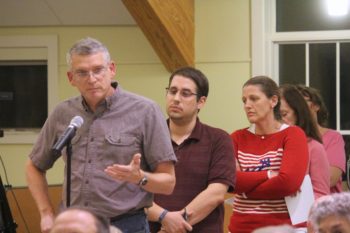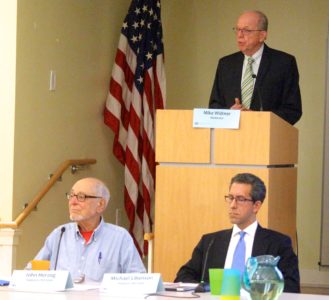Photo: Martin Plass (left) after the forum on the Minuteman finance vote.
Martin Plass was raised in Aachen, Germany, a country where technical schools – the Berufsschule – are held in the same esteem as the other secondary education placements in the country.
“[In Germany], vocational training is seen as a great career path where you are taken into an apprenticeship, and it’s respected,” said the Stanley Road resident.
But the Precinct 3 Town Meeting Member believes that in many communities teaching practical skills so students can enter manufacturing, business or technical jobs “is looked down on.”
That feeling, Plass said after a community forum held Monday, Sept. 12 at the Beech Street Center on funding a new $145 million Minuteman Technical High School, is held by many residents in Belmont.
“People here will say, ‘I want the best possible school for Belmont High’ because they have children there. But they seem to say we can’t have that for our children who want a more practical work experience. That’s a shame,” said Plass.
For Plass and many who attending the forum co-sponsored by the League of Women Voters and the town’s Warrant Committee, the prospects of town voters casting a no vote on Wednesday, Sept. 20 during an election being held in the 16 communities who send students to Minuteman is short-sighted when considering the alternative.
But for those residents who are pushing for voters to reject the proposed $100 million in debt – the state’s School Building Authority will pick up $45 million – the 10 remaining municipalities (six communities have voted to leave the district but will still vote on the plan) will finance over 30 years, the fiscal burden taxpayers and the town’s budget are being asked to carry can not be justified under the current agreement and assumptions made by the Minuteman administration.
“The bottom line is that Belmont taxpayers should save over $200,000 … or perhaps $400,000 per year by being a nonmember town with the same educational outcomes we all care about,” said Michael Libenson, the chair of the Warrant Committee which last week voted 13-1 against the new school financing plan.
What the Sept. 20 election is not about, reiterated Libenson, is a referendum on vocational or technical education “which virtually everyone I know in town feels very strongly about.” Nor would it halt the building of the new school while protecting the placement of Belmont students at the Lexington-based school for at least seven years.
The forum was the last opportunity publically for both sides to express what in many cases are long-standing reasons for their support or opposition.
On the no side, it comes down to the facts on the ground. Libenson, who presented for the no side in opening remarks, said the main issue is that the school, which is being built for 628 students, today enrolls 331 students or about 50 percent of the total pupil population from the ten member districts. The other students, coming from Watertown, Waltham and Medford to name a few towns, pay a tuition to attend the school.
“It’s a fundamental problem because it means the non-member towns are paying meaningfully less to send students to the school,” said Libenson. On average, Belmont spends $30,600 per student to attend the school while Watertown, which sends 63 students, pays $19,700 in tuition per student a year or $10,900 less on a per student basis.
One of the assumptions of the “yes” voters is the new Minuteman can attract more in district students to the school to fill the 635 seats. But Libenson said this claim would require a 40 percent increase in enrollment, something that is counter to the steady decline of students entering the school over the past 20 years.


Belmont had been working with the other member districts to solve this issue, but the 15 communities wanted to build the new school first before tackling the problem of equity spending by non-members.
While the state’s Department of Elementary and Secondary Education can add a surcharge onto the tuition of non-member students to help pay for the $100 million in capital expenses facing the member towns, it’s unknown how much, if any, DESE will authorize as it has not made a decision on the matter.
The case for voting no is a compelling one, said Libenson, coming down to a simple equation: it’s better to rent than buy.
“It’s much more sensible for Belmont to rent seats at Minuteman or other vocational schools than to buy into this 30-year debt authorization,” he said, advising town officials to call for a Special Town Meeting in October where it will ask to leave the district.
The ultimate goal of the no side – a Brexit-like move from Minuteman – would be “dangerous for Belmont students and the reputation of the town,” warned John Herzog, a retired professor who spoke for the yes side.
A parent and grandparent of students in the Belmont schools, Herzog said the no side does not have a better plan for Belmont vocational students “but only complaints.”
“If we are to take this giant step of leaving we should hear what they have in mind,” said Herzog. With an outstanding reputation that sends up to 68 percent of students to college and higher education, “why do you want to get out of [Minuteman]?” especially if any backup plan does not guarantee places for future Belmont students at existing technical schools.
In the long run, Belmont is being asked to finance about $335,000 per year over 30 years, which is an increase of $70 per year on the average tax bill, “which is a slight amount to pay for an excellent school,” said Herzog.
The question and answer portion of the night revolved around the mathematics of whether to stay and leave the district with those in the no column returning to the significant savings the town will accrue by leaving while the yes side, voiced by Laura Vanderhart of Precinct 4 and Agassiz Avenue, who pondered, “what are we giving up?”
“I think [Minuteman is] going to be more popular,” she said, pointing to efforts by the federal government and promises from politicians from Democratic Vice President candidate Tim Kaine and Belmont’s US Rep. Katherine Clark to support vocational and technical training.
Leaving the district would also place a burden on Belmont and other non-district students, according to Minuteman school officials who attended the meeting. Belmont residents would lose their preference taking specific courses of study or even no be accepted to the school as Minuteman reaches capacity.
But the no supporters believe the assumptions presented by those favoring remaining in the Minuteman district – from increased enrollment and enticing towns to join the district to the amount of a capital surcharge placed on out-of-district tuition – is a financial risk the town should not commit itself.
“I’m not prepared today to enlist us to continue that subsidizing the non-member communities unless they are prepared to pay their fair share of the capital expenses,” said Selectmen Chair Mark Paolillo, who joined his fellow member to recommend a “no” vote on Sept. 20.
For Plass, the writing is on the wall, as he is predicting Belmont will both vote “no” on Sept. 20 and a 2/3 vote to leave the district will pass at a Special Town Meeting in October.
“I think it’s naive of town officials to think they can do vocational training cheaper when there is a new building at Minuteman with wonderful classes,” he said.
“That will be a sad day for Belmont.”








Leave a Review or Comment